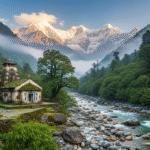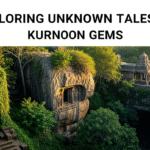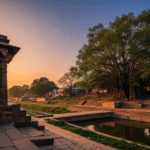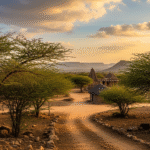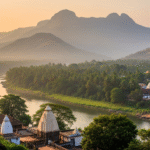Imagine standing beneath a monument that has seen empires rise and fall. Or running your fingers over ancient carvings, their creators’ stories preserved in stone. As you traverse India, the monuments you encounter whisper tales from the past. They’re not just structures but storytellers, urging you to dive deep into history’s embrace.
The vibrant cultural heritage of India is captured in its historic sites. Each ancient location narrates a unique story. From the Taj Mahal’s grand marble to Agra Fort’s formidable walls, you’ll feel the pulse of India’s rich past. The country’s diverse heritage is reflected in its landmarks. Here, history seekers and architecture aficionados find a treasure trove of cultural richness.
Key Takeaways
- Discover the profound impact of India’s history through its ancient sites and historical landmarks.
- Connect with the enduring love and romance symbolized by the magnificent Taj Mahal.
- Appreciate the rich tapestry of cultural heritage India offers through its diverse array of monuments.
- Unearth the stories behind the formidable red sandstone of the Agra Fort.
- Plan your visit effectively with key information on timing and entry fees for visiting these historic places in India.
- Experience the intricate artistry and spirituality embodied by India’s ancient temples and forts.
The Taj Mahal: An Icon of Eternal Love
The Taj Mahal stands as a majestic symbol, captivating hearts with its beauty. It’s among the most famous monuments in India. Built by Mughal Emperor Shah Jahan, this ivory-white marble edifice is a tribute to love for his wife, Mumtaz Mahal. It’s also a masterpiece of Mughal architecture, drawing global attention.
Unraveling the Love Story Behind the Marble Mausoleum
The origin of the Taj Mahal is as moving as its grandeur. Following Mumtaz Mahal’s death, Shah Jahan vowed to immortalize her. She was not just his wife but also the mother to his 14 children. This commitment led to the creation of this iconic landmark in India.
Architectural Splendor: Design and Construction
The construction of the Taj Mahal is an epic tale of dedication and artistry. It took from 1631 to 1653 to complete, employing over 20,000 workers and 1,000 elephants for material transport. Its main dome is an acoustic phenomenon, capturing and amplifying even the softest whispers. The design integrates Islamic, Persian, and Indian elements, marking it as a must-visit historical site in India.
Visiting the Taj: Timings and Entry Fee
The best times to visit the Taj Mahal are during early morning or late afternoon. It opens 30 minutes before sunrise and shuts 30 minutes before sunset. There’s also a special viewing near the full moon, offering a unique perspective under moonlight. Entry fees differ by nationality, aiding in the monument’s upkeep. This practice ensures that this UNESCO World Heritage Site remains accessible and preserved for worldwide visitors.
- Opening times: 30 minutes before sunrise to 30 minutes before sunset
- Night viewing on five days around the full moon
- Different entry fees based on visitor’s nationality
The Taj Mahal is a beacon for those passionate about history, architecture, or seeking inspiration. Its magnificent allure and historical significance continues to bewitch travelers. Indeed, it stands as a pivotal destination for any journey, embodying both an enduring love story and extraordinary beauty among the famous monuments in India.
Agra Fort: The Red Sandstone Giant
Agra Fort stands as a testament to Mughal architectural skill and India’s rich history. It is built mainly from red sandstone. This grand complex draws both enthusiasts and historians, making it a must-see among India’s historical palaces.
The fort spans about 38 hectares and saw major renovations under Emperor Akbar from 1565 to 1573. Originally, it was home to 500 buildings that displayed Bengal and Gujarat’s architectural styles. Now, only thirty remain. In 1984, its global importance was acknowledged when it became a UNESCO World Heritage Site.
The fort boasts walls that are seventy feet high, double ramparts, and grand circular bastions. These features are not just for show; they played a vital role in its defense. Among its four gates, the Delhi Gate and the Lahore Gate stand out. They reveal much about the fort’s rich history and its part in major events.
Within its walls, Agra Fort has been the backdrop for key moments like the Indian Rebellion of 1857. This rebellion was crucial, leading to the British East India Company’s downfall. Also, a tragic event in 1871, a gunpowder explosion, caused 36 deaths here.
As a beacon of architectural and historical significance, Agra Fort invites travelers to uncover its story. It highlights the splendor of Mughal architecture. Its red sandstone walls hold countless tales waiting to be discovered.
Agra Fort is an essential visit for anyone interested in India’s historic sites or historical palaces. It offers a deep dive into the architectural marvels and historical stories that have shaped this area.
Delhi’s Architectural Duo: Red Fort and Qutub Minar
Delhi, the vibrant heart of India, is home to landmarks of monumental significance. The Red Fort and Qutub Minar are iconic, reflecting Delhi’s historic majesty. Through these sites, one delves into India’s rich historical and architectural narratives.
Red Fort: A Historical Witness to India’s Independence
The Red Fort stands as a testament to India’s eventful past, with its red sandstone walls capturing the essence of Mughal architecture. This fort, built in the 17th century by Emperor Shah Jahan, who is credited with constructing the Taj Mahal, has witnessed crucial episodes in India’s struggle for freedom. It is here that the Prime Minister annually commemorates India’s independence, echoing the fort’s legacy of resistance.
Qutub Minar: The Tower that Speaks Volumes
The Qutub Minar, dating back to the 12th century, symbolizes the onset of Muslim rule in India following the defeat of Delhi’s last Hindu king. Its design is a testament to the rich architectural evolution during Muslim dominance, with intricate carvings and Islamic inscriptions. At its base is India’s oldest mosque, the Quwwat-ul-Islam Mosque, adding to its historical significance.
Exploring these ancient sites bridges the past and present, offering a glimpse into Delhi’s architectural splendor and historical depth. The Red Fort and Qutub Minar are not just structures but storybooks of India’s past. Each visit enriches understanding, making them essential for those captivated by India’s history and culture.
The Essence of Mughal Architecture: Humayun’s Tomb
Humayun’s Tomb stands as a pivotal piece of India’s architectural legacy, embodying Mughal era grandeur. This monumental tomb reflects the era’s architectural sophistication and represents a significant evolution in Mughal design.
Empress Bega Begum initiated its construction in 1565 as a tribute to Emperor Humayun, her late husband, completing it in 1572. Located in Delhi, it blends Persian and Indian elements, setting a standard for later marvels like the Taj Mahal. The structure is distinguished by red sandstone and Persian motifs, introducing the charbagh garden layout, mirroring paradise in Islamic culture.
Did you know? Humayun’s Tomb was the first garden-tomb on the Indian subcontinent, setting a benchmark for many future royal mausoleums in the region.
The complex encloses over 100 gravestones, known as ‘The Dormitory of the Mughals’, each holding stories of a bygone era. Its architecture is highlighted by a 42.5 meters high dome. Additionally, marble and precious stones embellish the mausoleum’s interior and exterior, enhancing its grandeur.
| Fact | Detail |
|---|---|
| UNESCO World Heritage Status | 1993 |
| Adjacent Monument | Isa Khan Tomb Complex (constructed 1547 CE) |
| Cost of Construction | 1.5 million rupees |
| Influence on Other Architecture | Taj Mahal, noted for similar design, architecture elements and garden layout |
| Restoration Period | Significant efforts since the 1900s, major project from 1997 onward by Aga Khan Trust |
More than a mausoleum, this marvel represents a deep narrative of imperial pride, artistic pursuit, and a glimpse into India’s rich architectural heritage. It is crucial for historians and architecture enthusiasts globally, offering insights into Mughal architecture’s impact over centuries.
The Royal Enclave: Fatehpur Sikri
Exploring Mughal era India? Fatehpur Sikri is the essence of royal Mughal urban planning, created during Emperor Akbar’s peak reign. It’s not just a monument within historical destinations in India, but a lasting emblem of a once-majestic empire.
Founded in 1569 and serving as the capital until 1585, Fatehpur Sikri seamlessly merges Mughal innovation with Persian architectural elements. This is evident in the extensive use of red sandstone and the elaborate carvings on many palatial structures.
Now a deserted city, Fatehpur Sikri still captivates with its landmarks. The Panch Mahal shines as a magnificent five-storied construction, held up by 176 columns. Meanwhile, the Buland Darwaza acts as a towering gateway, erected to commemorate Akbar’s victory in Gujarat. The Tomb of Salim Chishti, carved in pristine white marble, radiates tranquility and spiritual allure.
| Feature | Description |
|---|---|
| Population (Current) | 32,905 |
| Literacy Rate | 52.4% |
| Female Literacy Rate | 43.4% |
| Scheduled Castes Population | 4,110 |
| Language Dominance | 98.81% Hindi, 1.04% Brajbhasha |
| Historical Significance | Former Mughal capital with a rich collection of architectural marvels, reflecting a blend of Islamic and Persian influences |
| Main Attractions | Panch Mahal, Buland Darwaza, Tomb of Salim Chishti |
When wandering through Mughal era India, the architectural wonder that is Fatehpur Sikri is a sight to behold. It stands out as essential for anyone passionate about history.
Cultural Fusion at the Hawa Mahal in Jaipur
The enchanting city of Jaipur welcomes you with the Hawa Mahal, also known as the Palace of Winds. Its breathtaking Rajput architecture, fused with Islamic and Mughal elements, captures your imagination. Constructed in 1799 by Maharaja Sawai Pratap Singh, it showcases India’s vibrant cultural heritage.
The palace’s unique five-story design is celebrated for its detailed latticework with 953 small windows, known as ‘jharokhas.’ These features craft a stunning visual of a honeycomb. Its design was pioneering both aesthetically and functionally. It allowed royal women to watch street festivals unseen, blending beauty with purpose.
The Hawa Mahal’s exterior is a design marvel and an engineering masterpiece. It elevates Rajput architecture’s status. The theme of India’s cultural legacy is visible throughout this magnificent structure. Ancient grandeur is paired with practicality.
Hawa Mahal has been a central venue for sustaining Rajasthan’s heritage. It hosts cultural performances and events that draw global tourists. These gatherings celebrate traditional Rajasthani arts and crafts. They enrich India’s cultural mosaic.
| Year Built | 1799 |
|---|---|
| Architect | Maharaja Sawai Pratap Singh |
| Number of Windows | 953 |
| Architectural Style | Rajput, Islamic, Mughal |
| Cultural Significance | Hosts traditional Rajasthani events |
| Renovation Efforts | Meticulous restorations undertaken |
| Featured In | Multiple Bollywood films |
Over the years, the importance of Hawa Mahal as living history has remained clear. The efforts to preserve it highlight its role in Rajput architecture. As a key landmark in Jaipur, its story and structure are vital to India’s architectural narrative.
Khajuraho Temples: Narratives in Stone
The Khajuraho Group of Monuments, famed as UNESCO World Heritage Sites in India, illustrates the pinnacle of the Chandela dynasty’s architecture and culture. Encrusted with tales of divinity and worldly desires, these ancient temples draw scholars, tourists, and art lovers worldwide.
The temples, erected mainly between 885 CE to 1000 CE under Chandela rule, cover roughly six square kilometers. Initially consisting of over 80 structures, now just about 25 remain, each showcasing religious harmony and artistic brilliance. They merge Jain and Hindu motifs, narrating tales of devotion and creativity.
Understanding the Art: Sculptures and Symbolism at Khajuraho
Though famous for their sensual carvings, these form less than 10% of the artwork and spotlight celestial concepts like kama and moksha, crucial to Indian philosophy. The sculptures depict the harmony of earthly and spiritual desires, highlighting ancient India’s vast cultural stories.
| Temple Name | Dedicated to | Orientation |
|---|---|---|
| Kandariya Mahadeva | Lord Shiva | Sunrise-facing (East) |
| Devi Jagdamba | Devi (Goddess) | Sunrise-facing (East) |
| Chausath Jogini | 64 Yoginis | Non-sunrise-facing |
| Vishwanath | Lord Shiva | Sunrise-facing (East) |
Plan Your Visit: Timing and Cultural Significance
Exploring these UNESCO sites provides a deep dive into the spiritual and artistic diversity of ancient Indian temples. Their design, incorporating the mandala concept, aligns the cosmic universe with architectural forms. Thus, visitors gain a profound sense of the universe’s order.
To fully grasp Khajuraho’s historical splendor, do not miss the evening light and sound show. This spectacle not only enhances the visual appeal but also deepens the historical context of the Chandela dynasty’s legacy.
Conclusion
Exploring India lets you travel through a rich tapestry of history and admire architectural wonders that characterize Indian heritage sites. From the peace of Punjab’s Golden Temple to the Taj Mahal’s majesty, every monument narrates a piece of India’s cultural saga. These iconic structures are not just remarkable for their beauty. They’re guardians of history, symbolizing the nation’s illustrious past.
Travelers come to India for spiritual enlightenment or to dive into its ancient history. They are encouraged to discover the tales carved into each monumental wonder. The Red Fort’s magnificent gates and Tamil Nadu’s exquisitely detailed temples provide fresh insights into India’s legacy. Varying ticket prices make these experiences accessible, highlighting that India’s true treasure is its history and culture.
In exploring sites like Gujarat’s Sabarmati Ashram and Rajasthan’s stunning Hawa Mahal, your journey becomes a narrative of courage, devotion, and progress. This content’s 12,243 views indicate a worldwide fascination with India’s heritage. For more information or to quench your curiosity further, contact us at 1800 – 2588 – 074 or email [email protected]. Remember, each step through India’s magnificent landscapes and historic sites reminds us of her perpetual glory.
FAQ
What is the best time to visit the Taj Mahal?
The ideal period to visit the Taj Mahal spans from November to February, when temperatures are milder. This iconic monument welcomes visitors shortly before the sun rises and shuts just before it sets. On days surrounding the full moon, it also offers nighttime viewings.
Are there any entry fees for India’s historic sites?
Indeed, entry fees are charged at most historical sites in India. The cost varies, depending on the site and your nationality. Fees are different for Indian citizens, citizens from SAARC and BIMSTEC countries, and those from elsewhere.
Can you tell me more about the architectural style of the Agra Fort?
The Agra Fort, known as the Red Sandstone Giant, showcases Mughal architecture. It merges Islamic and Persian designs. The complex is famous for its elegant decor and historical depth, reflecting the Mughal Empire’s splendor.
What are the must-see attractions within the Red Fort in Delhi?
Within the Red Fort, key attractions await visitors. These include the Lahore and Delhi Gates, Diwan-i-Aam, Diwan-i-Khas, the Pearl Mosque, Rang Mahal, and the Archaeological Museum. Each spot offers a unique glimpse into India’s rich history.
What historical significance does Qutub Minar hold?
Qutub Minar symbolizes the onset of Muslim influence in Delhi following the defeat of the last Hindu ruler. Erected to commemorate Muslim rule in India, it stands as a prime example of Indo-Islamic architecture.
What are some key features of Humayun’s Tomb?
Humayun’s Tomb, a UNESCO site, is acclaimed for its breathtaking architecture. Noteworthy aspects include its charbagh garden layout, imposing central arch, and exquisite detail combining Persian and Indian styles. It serves as the final resting place of Emperor Humayun.
What makes Fatehpur Sikri unique?
Fatehpur Sikri reflects a harmonious blend of Hindu and Islamic architecture. Its well-preserved structure highlights the ingenious vision of Emperor Akbar. Iconic structures like the Buland Darwaza and Jama Masjid define its grandeur.
Why is Hawa Mahal an iconic monument?
Hawa Mahal, or ‘Palace of Winds,’ is renowned for its unique façade that includes 953 small windows. Its design not only promotes air circulation but also enabled royal women to observe street festivities unseen.
What is the historical importance of the Khajuraho Group of Monuments?
The Khajuraho Monuments, celebrated for their artistic sculptures, mark a high point in temple art from the Chandela period. These UNESCO-protected temples exhibit the diverse facets of life, intertwining spirituality with human desire.
Is photography allowed at historical sites in India?
Photography for personal use is mostly permitted across historical sites, but restrictions may apply for tripods, flash use, and specific areas. Requirements for commercial photography can include special permissions and possibly, extra fees.


